
 |
Tea Clipper |
 |
| from TeaAntiques.com | ||
| Edition Seventy Six |
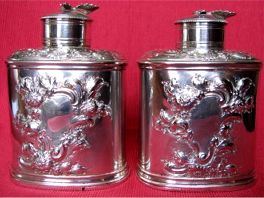 A
really magnificent and rare pair of George II oval tea canisters, complete with
their domed lids and sliding removable bases. These remarkable tea canisters are
the work of Samuel Taylor who made them in London in 1754. They are beautifully
decorated with chased floral decoration to both sides of each canister in a rococo
cartouche shape. They are also decorated on the shoulder with more chased floral
decoration. They each have a domed lid, used for measuring out the tea, these having
delightful cast flower finials. The base of each canister is removable by sliding
them out, so that the canister can be filled with tea.
A
really magnificent and rare pair of George II oval tea canisters, complete with
their domed lids and sliding removable bases. These remarkable tea canisters are
the work of Samuel Taylor who made them in London in 1754. They are beautifully
decorated with chased floral decoration to both sides of each canister in a rococo
cartouche shape. They are also decorated on the shoulder with more chased floral
decoration. They each have a domed lid, used for measuring out the tea, these having
delightful cast flower finials. The base of each canister is removable by sliding
them out, so that the canister can be filled with tea.
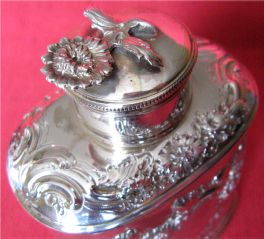
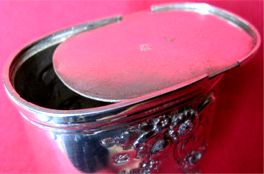
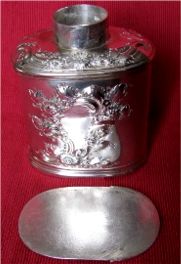
These stunning tea canisters are each hallmarked on the body of the canisters themselves, on the inside of the lids and on the removable bases.
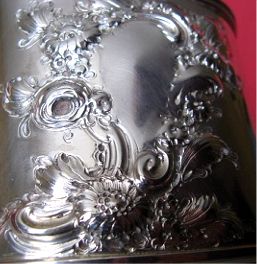
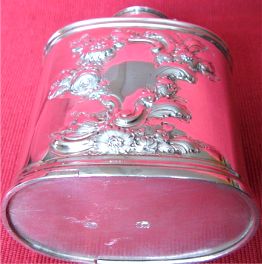
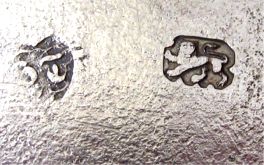
The quality of these tea canisters is second to none. They are very heavy for their size and thus robust. The condition of them is excellent. A very fine and rare pair of George II tea canisters - a fantastic pair for the connoisseur collector of early English silver or tea wares.
More details of this item and other tea related antiques can be found by visiting my web site at www.TeaAntiques.com.
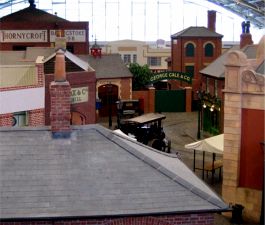 Quite
often my tea clipper articles relate to the grand houses of England, with their
fine collections of furniture and works of art. So, in this edition, I take a look
at the industrial revolution period in the nineteenth century and look at what life
was like for the middle and lower classes of society, from there through a
'time tunnel to the 1930's. What better place to take a look back at this part of
history that the 'Milestones' living museum in Basingstoke, Hampshire.
Quite
often my tea clipper articles relate to the grand houses of England, with their
fine collections of furniture and works of art. So, in this edition, I take a look
at the industrial revolution period in the nineteenth century and look at what life
was like for the middle and lower classes of society, from there through a
'time tunnel to the 1930's. What better place to take a look back at this part of
history that the 'Milestones' living museum in Basingstoke, Hampshire.
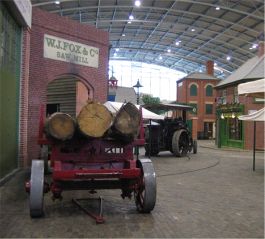 This
fascinating museum, opened in 2000 by HRH The Duke of Edinburgh, is the ideal place
to visit during the winter months too when most Stately homes close their doors
until the late Spring next year! The museum takes its name from a mid twentieth
century board game called 'Milestones', which took the players through many of life's
encounters, in the same way that this museum does for the visitor. The exhibits
of our past show how we have arrived at today's technology and how we progress into
the future.
This
fascinating museum, opened in 2000 by HRH The Duke of Edinburgh, is the ideal place
to visit during the winter months too when most Stately homes close their doors
until the late Spring next year! The museum takes its name from a mid twentieth
century board game called 'Milestones', which took the players through many of life's
encounters, in the same way that this museum does for the visitor. The exhibits
of our past show how we have arrived at today's technology and how we progress into
the future.
Housed in a very large modern hanger-like building, it provides the visitor with many hours of entertainment. Admission charge includes a free audio guide, which provides a great deal of information about the exhibits, which you may otherwise miss out on. There is also a café within the building; I found it an ideal place to take a break for tea and refreshments before continuing with the museum - as there is a lot to take in during your visit.
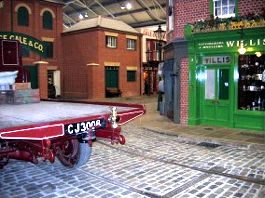 Many
of the buildings in the museum are based on real ones which have been recreated
as accurately as possible, proving an authentic place in which to create the displays.
Buildings have been erected to create a town layout within the space available,
so may have been scaled down to be accommodated. After paying for entry, you can
see the extent of the museum down below from the mezzanine floor which houses the
shop and cafe. The re-creation of the town is clear from the varied roof line
of the buildings, the streets and vehicles etc.
Many
of the buildings in the museum are based on real ones which have been recreated
as accurately as possible, proving an authentic place in which to create the displays.
Buildings have been erected to create a town layout within the space available,
so may have been scaled down to be accommodated. After paying for entry, you can
see the extent of the museum down below from the mezzanine floor which houses the
shop and cafe. The re-creation of the town is clear from the varied roof line
of the buildings, the streets and vehicles etc.
Taking a lift down to the museum display level you are about to enter the past, where history is brought to life before you.
From the 1750s English life, which revolved around the great landed gentry with their tenanted estate farms, was about to change. With the improvements in farming, introduction of labour saving machinery and the farming taken over by firms meant that the peasants had to move to the cities, providing the necessary labour force needed for the later industrial revolution, with increased sale of goods overseas.
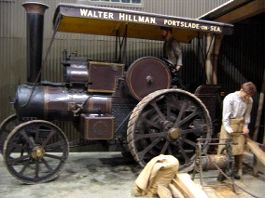 The
development of the steam engine was a crucial part in the industrial growth of the
country. This could provide the power for all sorts of newly invented machinery,
whether it be in a large factory, workshop or in transport. Steam engines were made
by several companies including a local company, Tasker's of Andover. Some examples
of these steam engines are displayed. There is a re-creation of Tasker's factory
showing how they produced these essential pieces of technology. The invention of
Cast Iron meant that many new things, including parts to make steam engines, could
be made by moulding molten metal, rather than to forge metal by heating and hammering.
The
development of the steam engine was a crucial part in the industrial growth of the
country. This could provide the power for all sorts of newly invented machinery,
whether it be in a large factory, workshop or in transport. Steam engines were made
by several companies including a local company, Tasker's of Andover. Some examples
of these steam engines are displayed. There is a re-creation of Tasker's factory
showing how they produced these essential pieces of technology. The invention of
Cast Iron meant that many new things, including parts to make steam engines, could
be made by moulding molten metal, rather than to forge metal by heating and hammering.
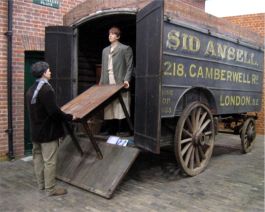 Outside
in the Tasker's yard there are the bunkers of the raw materials necessary to produce
cast iron and just outside the yard, the workers tiny cottages, built by Tasker's
to house their workforce near to their place of work. The terraced houses have no
front garden, opening out directly onto the street. Their few possessions and furniture
may have been moved to their city cottage by the 'pantechnican', a removal van that
could be transported by train and also drawn by a horse, thus provided an efficient
removal method. Here a pantechnican, belonging to Sid Ansell of Camberwell Road
in London, is delivering furniture and belongings to one of the little workers cottages
in Anna Valley Place.
Outside
in the Tasker's yard there are the bunkers of the raw materials necessary to produce
cast iron and just outside the yard, the workers tiny cottages, built by Tasker's
to house their workforce near to their place of work. The terraced houses have no
front garden, opening out directly onto the street. Their few possessions and furniture
may have been moved to their city cottage by the 'pantechnican', a removal van that
could be transported by train and also drawn by a horse, thus provided an efficient
removal method. Here a pantechnican, belonging to Sid Ansell of Camberwell Road
in London, is delivering furniture and belongings to one of the little workers cottages
in Anna Valley Place.
Across the street from the worker's cottages is a Tobacconist shop. This I am sure would have been in great demand, supplying the needs of the smoker with all the necessary accoutrements, including pipes, tobacco boxes, cigarettes etc.
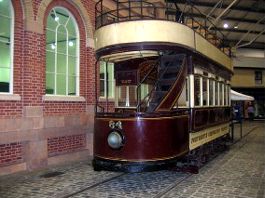
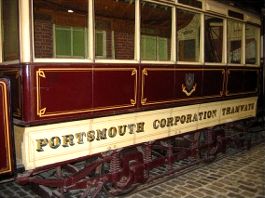 Anna
Valley Place opens out to the town's High Street. As you make your way down along
the High Street, to your left is the Tram shed, which housed the street tram transportation
system. The Victorian Tram invention allowed for cheap transport, which meant that
workers could afford to live further away from their place of work. A tram from
the Portsmouth Victorian tram network is housed in the museum, which ran on sunken
metal rails in the cobbled streets and took its power from overhead electric cables.
I was particularly fascinated by this tram as it would have run past my own house
in Portsmouth, where a section of cobbled street with the original tram tracks remain.
Anna
Valley Place opens out to the town's High Street. As you make your way down along
the High Street, to your left is the Tram shed, which housed the street tram transportation
system. The Victorian Tram invention allowed for cheap transport, which meant that
workers could afford to live further away from their place of work. A tram from
the Portsmouth Victorian tram network is housed in the museum, which ran on sunken
metal rails in the cobbled streets and took its power from overhead electric cables.
I was particularly fascinated by this tram as it would have run past my own house
in Portsmouth, where a section of cobbled street with the original tram tracks remain.
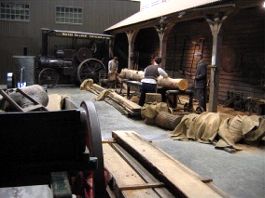
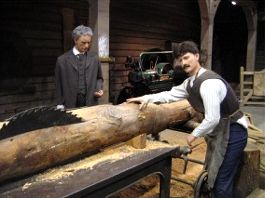 Adjacent
to the tram shed, there is a Saw mill. Here the trunks of trees were sawn into planks,
which were then left stacked to season, before going on to be used for all sorts
of things from house construction to furniture making. Seasoning is necessary to
prevent the timber from cracking and splitting. In the yard of the sawmill is a
very large circular saw, this powered by a steam traction engine connected to the
saw by a belt system. Safety regulations for workers in such industrial situations
had not been regarded and so they were very dangerous places in which to work; a
saw like this could easily remove the limb of a careless worker!
Adjacent
to the tram shed, there is a Saw mill. Here the trunks of trees were sawn into planks,
which were then left stacked to season, before going on to be used for all sorts
of things from house construction to furniture making. Seasoning is necessary to
prevent the timber from cracking and splitting. In the yard of the sawmill is a
very large circular saw, this powered by a steam traction engine connected to the
saw by a belt system. Safety regulations for workers in such industrial situations
had not been regarded and so they were very dangerous places in which to work; a
saw like this could easily remove the limb of a careless worker!
Turning right from the High Street into Station Approach, the Portsmouth tram can be seem on the tram lines, the service connection with the town's railway station. The invention of the steam engine and the railways again meant that people could travel around the country more cheaply, taking work forces to where they were needed as well as providing higher class transportation for the gentry who may use them for getting about the country in relative comfort and speed. However, initially the railways provided a way to transport the much need coal to power the steam engines which fired the industrial revolution, passenger transport by rail was to follow on form that. There is a re-creation of a Victorian railway station booking hall, with its ticket office. Outside the booking hall a pony and trap convey some railway passengers and their luggage to the station, assisted to the train by the station porter. A coal yard outside the station was where masses of coal was delivered by train and from where it could be distributed by road to factories and house.
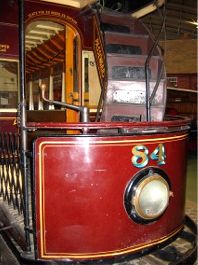
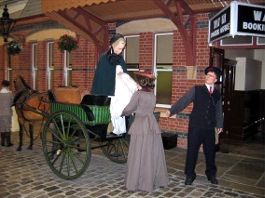
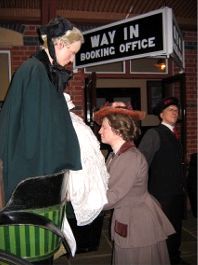
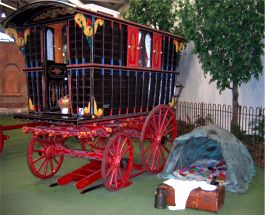
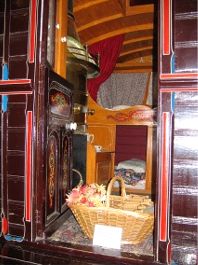 A
gypsy caravan is parked up on the edge of the agricultural showground. Gypsies were
a travelling workforce, moving around the country for seasonal work such as cherry
or strawberry picking. Their brightly coloured caravans were their pride and joy.
Inside this one you can see the fitted out caravan provides a snug home which was
drawn by a horse. The gypsies may also whittle clothes pegs to sell on their travels.
A
gypsy caravan is parked up on the edge of the agricultural showground. Gypsies were
a travelling workforce, moving around the country for seasonal work such as cherry
or strawberry picking. Their brightly coloured caravans were their pride and joy.
Inside this one you can see the fitted out caravan provides a snug home which was
drawn by a horse. The gypsies may also whittle clothes pegs to sell on their travels.
The agricultural showground, was a place for the manufacturers of farming machinery to show off and sell their latest traction engines, essential for 'modern' farming. The forerunner of the County Show.
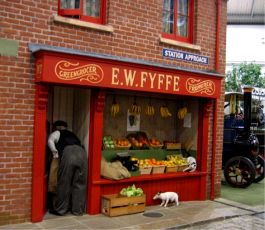
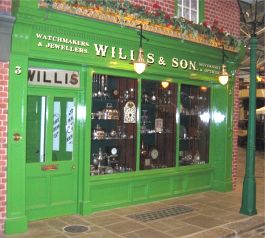 On
the end of Station Approach is a Greengrocer's shop. This has a stepped open front
displaying the available fruits and vegetables. By this time we were importing such
exotic fruit as bananas from the colony trading routes. Next to the Greengrocer's
is Willis's Jewellers shop. The window is lit from the outside by gas lights. This
was because if the window had been lit by gas light inside, the silver items would
have tarnished from the effects of the fumes! The shades of these lights are shaded
on the outer side to project the light into the window. The items on display here
show the range of goods that such a jeweller may supply. Note the copper tea urns,
as well as items of glass and silver, including a silver teapot.
On
the end of Station Approach is a Greengrocer's shop. This has a stepped open front
displaying the available fruits and vegetables. By this time we were importing such
exotic fruit as bananas from the colony trading routes. Next to the Greengrocer's
is Willis's Jewellers shop. The window is lit from the outside by gas lights. This
was because if the window had been lit by gas light inside, the silver items would
have tarnished from the effects of the fumes! The shades of these lights are shaded
on the outer side to project the light into the window. The items on display here
show the range of goods that such a jeweller may supply. Note the copper tea urns,
as well as items of glass and silver, including a silver teapot.
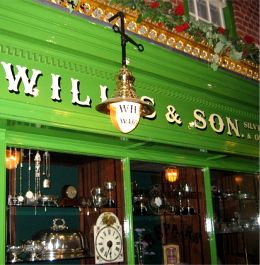
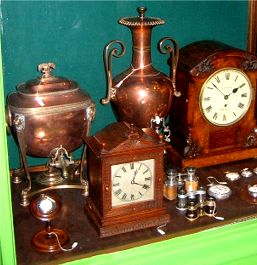
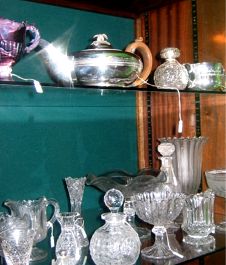
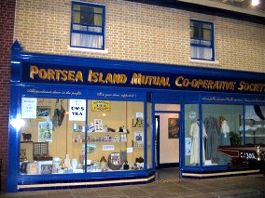 Opposite
the Jeweller's shop is one of the new type of 'Co-Operative Society' stores, selling
a wide range of goods. These goods, as displayed in the window, were packaged in
bright packaging, many pre-packed - a new idea. Such goods pre-packed and labelled
gave the customer confidence in what they were buying, with brand named goods. This
meant they could rely on the quality of what they bought and the price they paid.
There are some brands of items displayed that are still being supplied today, Lipton's
tea for example. The window has tea included for sale. A blue and white teapot is
sat on the edge of a small tea chest, full of tea and a notice giving the price
of the tea. There is even a notice in the window advertising their fine tea. It
was this type of store that eventually was to lead to our modern day supermarkets.
Opposite
the Jeweller's shop is one of the new type of 'Co-Operative Society' stores, selling
a wide range of goods. These goods, as displayed in the window, were packaged in
bright packaging, many pre-packed - a new idea. Such goods pre-packed and labelled
gave the customer confidence in what they were buying, with brand named goods. This
meant they could rely on the quality of what they bought and the price they paid.
There are some brands of items displayed that are still being supplied today, Lipton's
tea for example. The window has tea included for sale. A blue and white teapot is
sat on the edge of a small tea chest, full of tea and a notice giving the price
of the tea. There is even a notice in the window advertising their fine tea. It
was this type of store that eventually was to lead to our modern day supermarkets.
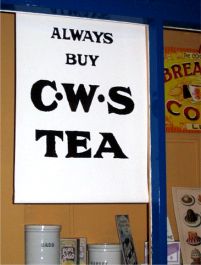
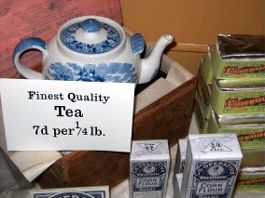
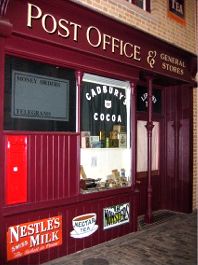
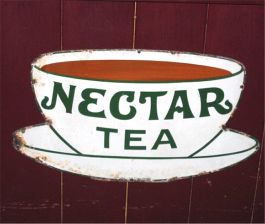
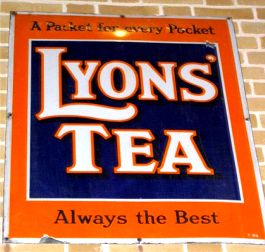
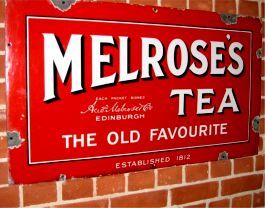
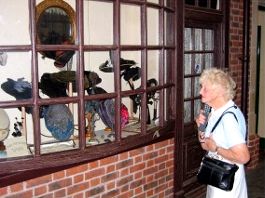 There
is a Milliner's (hat shop) opposite the Post Office. No respectable Victorian Lady,
or Gentleman come to that, would be seen out without wearing a hat. The window of
the shop is filled with the latest fashion in hats.
There
is a Milliner's (hat shop) opposite the Post Office. No respectable Victorian Lady,
or Gentleman come to that, would be seen out without wearing a hat. The window of
the shop is filled with the latest fashion in hats.
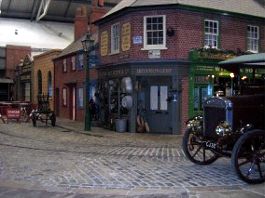 Jubilee
Street leads off the High Street. On the corner is an Ironmonger's, displaying all
sorts of hardware in the window and hung up outside the shop front. Tin baths hang
by the door, an important item for Victorian hygiene, the only way for man to be
able to take that once a week bath in front of an open fire! There are some cooking
utensils too, on the pavement outside is a 'clockwork' spit, this would have sat
in front of an open range and been used to cook a joint of meat, which would turn
via the clock work mechanism in front of the fire cooking the meat evenly all round.
Jubilee
Street leads off the High Street. On the corner is an Ironmonger's, displaying all
sorts of hardware in the window and hung up outside the shop front. Tin baths hang
by the door, an important item for Victorian hygiene, the only way for man to be
able to take that once a week bath in front of an open fire! There are some cooking
utensils too, on the pavement outside is a 'clockwork' spit, this would have sat
in front of an open range and been used to cook a joint of meat, which would turn
via the clock work mechanism in front of the fire cooking the meat evenly all round.
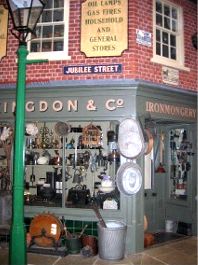
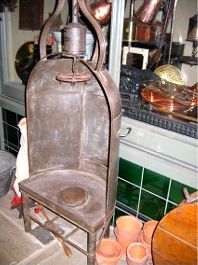
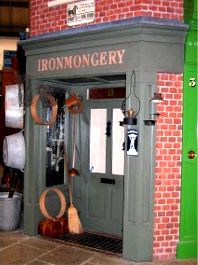
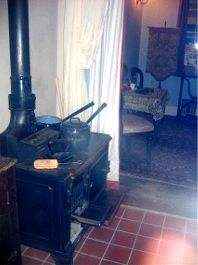
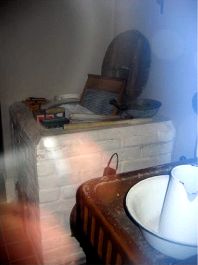 Next
door is a very tiny Edwardian Cottage. This narrow little cottage has just a tiny
living room at the front and a kitchen area out the back with maybe two bedrooms
on the first floor. All the cooking was done on a small cast iron coal fed range.
The washing of clothes and other linen items were boiled up in the 'copper' in one
corner of the kitchen. This a copper pan that had a wooden lid, filled with washing
and water it was heated by a coal fire underneath in the brick oven.
Next
door is a very tiny Edwardian Cottage. This narrow little cottage has just a tiny
living room at the front and a kitchen area out the back with maybe two bedrooms
on the first floor. All the cooking was done on a small cast iron coal fed range.
The washing of clothes and other linen items were boiled up in the 'copper' in one
corner of the kitchen. This a copper pan that had a wooden lid, filled with washing
and water it was heated by a coal fire underneath in the brick oven.
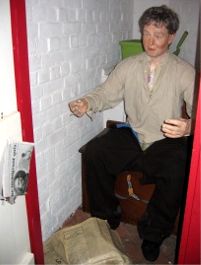 The
cottage had no bathroom or toilet inside. The was an outside 'privy' in the yard.
A soil pit toilet, a string of torn up newspaper proving the toilet paper! An early
form of recycling!
The
cottage had no bathroom or toilet inside. The was an outside 'privy' in the yard.
A soil pit toilet, a string of torn up newspaper proving the toilet paper! An early
form of recycling!
Other displays in Jubilee Street are a Gas Works, a Motor Company, the 'Baverstock Arms' public House and a Saddler's. In the cobbled street is a handsome omnibus, made by a local firm 'Thorneycroft', who later went on to make touring cars. It is in the Portsmouth bus company's livery. It is perhaps appropriate that it is parked just outside the Saddlers, whose business it might be affecting with the move away from horse powered transport!
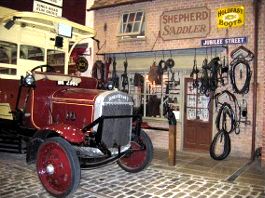

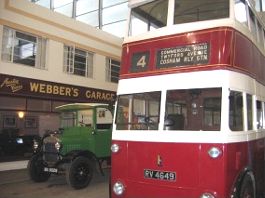
From the end of Jubilee Street, you are invited to pass through the 'time tunnel', from which you emerge into the 1930s. Here, the first thing that is evident is the change in road surface, no longer cobbled, but smoothly cover with asphalt. Also, the pavements are no longer of small cobbles, but now of paving stones. Some of the buildings round about are of the typical angular 1930's style, with metal framed windows.
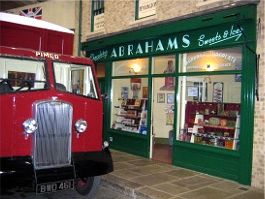 A
bicycle shop shows off some of the bikes available. It had been considered rather
unlady-like till now for them to ride bikes, but now, with bikes designed with a
drop cross bar, it was regarded as respectable. Next to the bicycle shop is a sweet
shop, the favourite of the 1930s children no doubt. Here jars of all kinds of confection
and boiled sweets were sold loose by the ounce. Weighted out on balance scales,
the sweets were wrapped in little paper bags, and the payment due rung up on the
till. Some pre-packed sweets and toffees were appearing, some in pretty or commemorative
tins.
A
bicycle shop shows off some of the bikes available. It had been considered rather
unlady-like till now for them to ride bikes, but now, with bikes designed with a
drop cross bar, it was regarded as respectable. Next to the bicycle shop is a sweet
shop, the favourite of the 1930s children no doubt. Here jars of all kinds of confection
and boiled sweets were sold loose by the ounce. Weighted out on balance scales,
the sweets were wrapped in little paper bags, and the payment due rung up on the
till. Some pre-packed sweets and toffees were appearing, some in pretty or commemorative
tins.
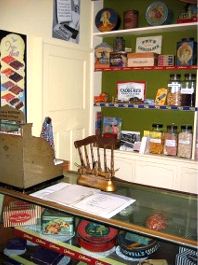
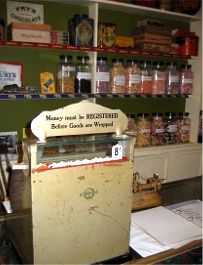
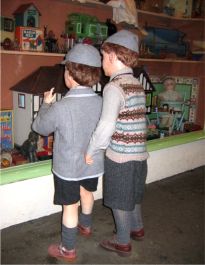
Another shop favoured by young children is the Toy Shop, here we see two young boys gazing at the toy shops window, dreaming of owning some of the toys, maybe the wind up 'clock-work' train? Dressed in their grey shorts, knitted tank top jumpers and sporting their school caps, they epitomise young children of the period.
For the adults, there is the Camera shop and the Gramophone and Radio Shop. People could now more afford such luxuries to use in their spare time. How different it must have been to be able to capture images of your family on your own camera, or to be able to listen to music on the radio, or music of your choice on a gramophone! Even car showrooms were springing up selling relatively affordable motor cars!
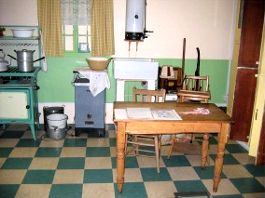
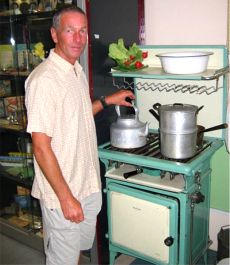 In
a corner of the museum, having been through the industrial revolution, Victorian
era, time tunnel to the 1930s, there is a display of some other items of domestic
use. There is a kitchen displaying the 1930s style and facilities and cabinets filled
with very interesting things including some very stylish automatic tea makers
- the way to wake up to a freshly brewed pot of tea in bed - luxury. I also spotted
a couple of tea infusers, spoons that are filled with loose tea enabling you to
make a cup of tea in a teacup without having the tealeaves left floating in the
tea.
In
a corner of the museum, having been through the industrial revolution, Victorian
era, time tunnel to the 1930s, there is a display of some other items of domestic
use. There is a kitchen displaying the 1930s style and facilities and cabinets filled
with very interesting things including some very stylish automatic tea makers
- the way to wake up to a freshly brewed pot of tea in bed - luxury. I also spotted
a couple of tea infusers, spoons that are filled with loose tea enabling you to
make a cup of tea in a teacup without having the tealeaves left floating in the
tea.
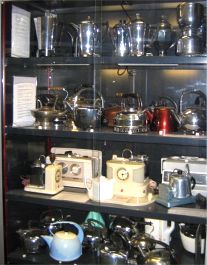
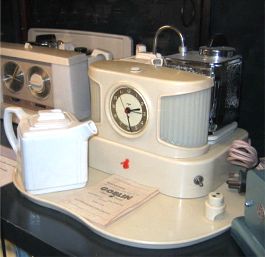
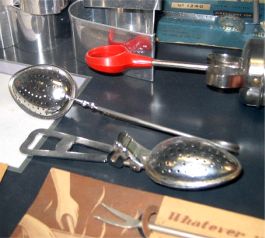
I am sure that a visit to 'Milestones' would provide many hours of fun and entertainment for all the family. An education, it also brought back some memories - not of the Victorian era I hasten to add!

- Milestones - Hampshire's living museum
- Leisure park,
- Churchill Way West,
- Basingstoke,
- Hampshire
- RG21 6YR
- www.milestones-museum.com
Not many miles from Milestones is the Hampshire village of Chawton, known for the house in which authoress Jane Austen lived for many years and wrote some of her works there. Situated opposite to the house in which Jane Austen lived, which is now a museum, is Cassandra's Cup tearoom.
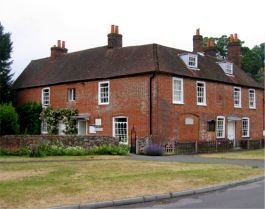
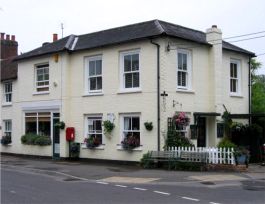
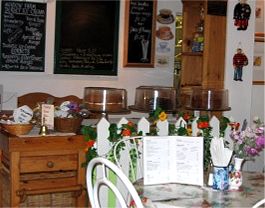
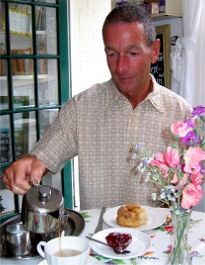
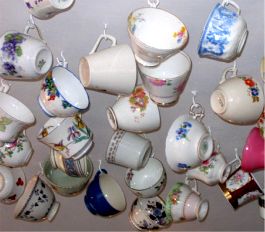 It
is a pleasant tearoom, well kept and has a decorative feature of a mass of various
teacups hanging from the ceiling! There are all sorts of designs, patterns, decoration
and age to be seen.
It
is a pleasant tearoom, well kept and has a decorative feature of a mass of various
teacups hanging from the ceiling! There are all sorts of designs, patterns, decoration
and age to be seen.
The shop serves a range of lunches as well as many cakes for afternoon tea. I had a home-made scone, which was warm, served with butter and jam. It is not the best tea I have had, but pleasant enough none the less. The shop is in a very pretty situation and kept very neat with brightly coloured table decorations.
To review past newsletters, just follow this link:
Past newsletters.
To subscribe to this free newsletter -
Click here